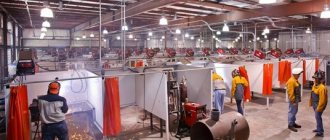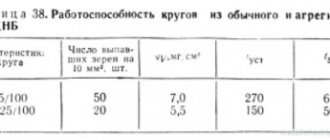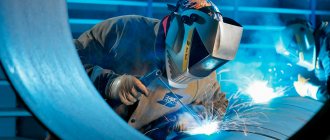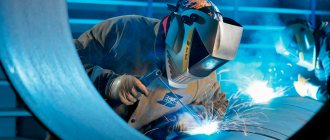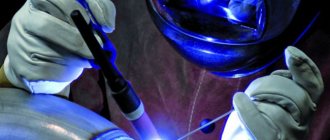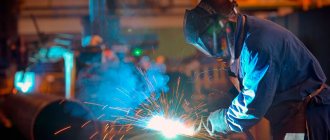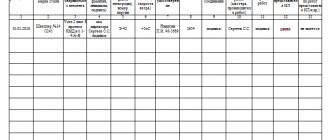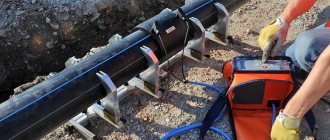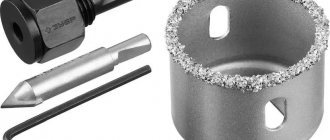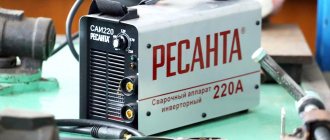Why is it important to follow labor safety rules in the welding area?
Safety precautions during welding work are a set of organizational and other measures that are aimed at eliminating the likelihood of injury or damage to the workpiece. This is due to the high likelihood of injury. It is important to follow labor safety rules when carrying out welding work for the following reasons:
- During operation, a current is supplied, the voltage and strength of which increase. Improper handling and careless handling of the equipment may result in electric shock.
- The electric arc can affect the skin or organs of vision. This is due to the high brightness of the arc, as well as strong heat generation.
- During operation, harmful gases may be released that have a negative effect on the respiratory system. High temperatures lead to the appearance of dust and various fumes.
- Mechanical injuries may occur during welding work. This is due to the fact that large parts are often connected. They must be firmly fixed during welding.
- There is a small chance of liquefied gas cylinders exploding. In a compressed state, the substance through which welding can be carried out becomes explosive.
- The danger of radiation charging during quality control of welds.
Welding work is carried out extremely often. Therefore, certain GOSTs and regulatory documents have been adopted, which, if followed, can reduce the likelihood of injury.
Download GOST 12.3.003-86
Working with electrical equipment
Electrical safety during welding requires the use of only serviceable and grounded equipment. Under this condition, electric shock to a person is completely excluded.
Safety regulations require that lighting fixtures be powered from 12 V, but in practice this is rarely done. The workers are completely dependent on the production owners and follow their orders, not safety regulations.
Despite this, knowing the basic requirements to ensure personal safety is useful in any situation. All equipment must operate at no-load voltage of no more than 90 V.
The lethal voltage is slightly higher - 110 V. A current strength of more than 5 hundredths of an Ampere can cause electrical injury and death.
The following safety rules can help protect against electric shock:
- All electrical appliances must have reliable and high-quality grounding and grounding. They are made of copper conductor with a sufficient cross-section;
- safety precautions require connecting welding equipment through an electrical panel to a separate circuit breaker and RCD device;
- the length of the wires for connecting welding equipment should not exceed 10 m. If there is a need to splice the wire at the break point, the connection must be made using a special coupling. It is better to hang the wires at a height of more than 2.5 m, and consumers need to lower them through a grounded steel pipe. All wiring locations must be equipped with special rubber couplings.
- When welding on the street or in the field, safety precautions recommend installing the welding machine under canopies or in covered pavilions. Work stops in case of heavy rain or snowfall;
- All cables and wires must have proper insulation. In case of significant damage and twists, the instructions require replacing the welding cable.
By taking safety measures in a timely manner when performing electric welding work, you can completely protect yourself and others from electric shock.
To gain access to the site, an employee must?
When hiring, all future employees are subject to certain requirements. Safety precautions when welding must be observed. Among the features of employee access to the site, we note the following points:
- Knowledge of safety precautions related to the supply of electricity must be checked.
- Only persons over 18 years of age may be allowed to perform welding work and enter the work area. At the same time, they must undergo training and obtain the appropriate permit.
- Proficiency testing may be carried out from time to time.
If a future employee does not have the appropriate education and skills, then he should not be allowed to work. The welder must also prevent strangers from entering the work area, as they may also be harmed.
Occupational safety when welding process pipelines
Areas of the installation site where pipeline welding is carried out must be fenced with screens, shields made of sheet steel or plywood treated with fire-resistant material, curtains made of asbestos cloth or tarpaulin to a height of at least 1.8 m. , fences should be painted grey, yellow or blue in a matte tone. Welding workplaces located more than 1 m above ground level (floor) must be fenced.
If it is impossible or impractical to install fencing, workers must be equipped with safety belts. The places where the carabiner of the safety belt is attached must be indicated in advance by the master or the workman and brightly colored. When welders work simultaneously at different heights along the same vertical, canopies, shields and flooring must be installed to protect workers from splashes of molten metal and falling objects.
It is necessary to post posters at the installation site warning about the possibility of eye irradiation and skin burns.
Welding work inside pipelines
Welding work inside pipelines is allowed if their nominal diameter is 1020 mm or more. Women are not allowed to weld inside pipelines. All hatches, fittings and other openings must be open. An observer must be constantly on duty at each end of the pipeline and positioned so that the welder can be seen and heard during welding work.
The switch (starter) of the welding equipment should be located near one of the observers. The observer behind the welder should hold the end of the signal rope, the other end should be securely attached to the safety belt or tied around the welder.
Welder's equipment for welding inside a pipeline
The electric welder must have a shield with a forced supply of fresh air. It is possible to work with the shield without forced air supply, provided that forced ventilation is used inside the pipeline. The air speed must be no less than 0.25 and no more than 1.5 m/s. In winter, air should be supplied at a temperature of at least 20°C. It is advisable to use portable local suction units equipped with devices for their quick and reliable fastening near the welding zone.
Lighting inside the pipeline
Lighting inside the pipeline should be provided from a step-down transformer with a voltage of no more than 12 V.
The welder must be provided with dielectric rubber mats, dielectric galoshes or boots, rubber gloves and a rubber helmet. Welders must wear helmets with canvas shoulder pads to protect their necks and shoulders.
When welding pipelines in wells, trenches, as well as to protect against contact with cold and wet soil or metal, bedding, mats, knee pads and armrests made of fire-resistant materials with an elastic layer should be used.
What hazards exist on the site?
There can be quite a few different hazards on a work site. When taking them into account, safety precautions are developed. The use of special equipment determines the following:
- There is a high risk of electric shock. If welding equipment is used incorrectly, current can spread through metal workpieces.
- Welding safety precautions are developed taking into account the likelihood of heat injury. At the time of welding, the workpiece is heated to high temperatures, the metal becomes liquid. If it comes into contact with an open area of skin, a burn may occur.
- If the elements being connected are not securely fastened, injury may occur. Fixation is also required in order to obtain a high quality seam.
- The resulting arc results in a bright flash. It can cause vision damage.
- When heating metals and various alloys, harmful gases can be released, which should not enter the respiratory tract.
Injury due to poor welding safety practices
In some cases, there may be other hazards on the site. An example is the case of using a cylinder with an explosive substance.
Respiratory and skin protection
An arc is formed during welding work. It causes the following effects:
- Light, as the arc becomes a source of a bright flash.
- Ultraviolet. Such exposure causes pain and stinging in the eyes, and in some cases, skin burns.
- Infrared radiation causes cataract damage.
In addition, harmful gases may be released, which, if ingested, can lead to headaches, vomiting and weakness. Some harmful substances can accumulate in tissues, leading to the development of diseases.
Respiratory and skin protection
The most widely used means of respiratory and skin protection are:
- Special welding masks. They protect the face from splashes of hot metal, as well as the eyes from bright light sources. There are a wide variety of masks available on sale; they are selected depending on the conditions in which welding is carried out and the preferences of the welder.
- Installation of a local ventilation system that provides air supply and exhaust. A similar system is required when welding is carried out indoors.
- In some cases, respirators and gas masks are required.
- In some cases, toxic consumables are replaced with safer ones.
- The automation and mechanization of the process is significantly increased when using various devices.
Protective equipment for welding work
You need to pay attention to choosing quality protection. This is due to the fact that there are a large number of low-quality products on sale. Safety precautions during welding work require the mandatory use of protective masks.
Basic rules of conduct
Electric welding produces intense heat and light, so safety regulations are designed to protect not only the welder, but also anyone who may be within range of the electrical flash.
Welding work should be carried out at specially equipped stations equipped with screens to protect others from harmful effects on the eyes. The height of the screens is at least 1800 mm.
If you are in a closed room, welding work should begin after preliminary ventilation with the supply ventilation turned on.
According to safety precautions when electric arc welding in closed containers or in rooms with damp conditions, you can work using rubber clothing and a mat. For protection when working in a sitting or lying position, a felt mat is required.
The integrity of the ground wire and welding cables should be constantly monitored. For welding work, you must use a reliable and high-quality tool and electrode holder.
When carrying out welding work to repair a machine, you must first disconnect the ground on the battery and ensure compliance with fire safety measures. When welding near the fuel tank, safety precautions require it to be dismantled.
When carrying out welding work at height, the welder is required to undergo safety training and obtain a work permit. Without these measures, it is prohibited to start work. Safety precautions require that the welder be properly insured and all tools secured. The insurance is carried out by an assistant.
Electrical equipment should only be rearranged after being disconnected from the network. If you need to leave your place of work for a while, the device is turned off and the holder is placed on a dielectric base.
Labor protection requirements before welding work
Safety precautions when carrying out welding work include preparation and inspection of equipment. This is due to the fact that it is often due to the poor technical condition of the welding inverter or consumables. That is why before carrying out work:
- The integrity of the device and auxiliary elements, as well as consumables, is inspected.
- Protective equipment must also be in good condition. Safety precautions include checking the integrity of all equipment.
- When working in hazardous conditions, scaffolding and other auxiliary structures are prepared.
- Attention is paid to grounding. It eliminates the possibility of electric shock.
- The housing of welding machines and machines must be reliably grounded. In this case, the likelihood of a short circuit occurring is significantly reduced.
- The integrity of the insulation of all cables must be checked. At the same time, they should not be in water during operation, since the reliability of the insulation is significantly reduced.
- Do not use a wire that is too long; the recommended figure is about 10 meters.
- Safe conditions are provided with a current of 12V. But in most cases, power can come from other power sources.
Safety precautions at the welding workplace
With proper preparation and safety precautions, a wide variety of problems can be avoided.
Industrial alpinism.
The essence of industrial mountaineering is that specially trained people, using rope equipment with appropriate insurance, perform the necessary production work on the walls of buildings and structures.
Specialists in this field are either professional climbers who have mastered painting skills, or craftsmen who have expanded the scope of their professional skills as a painter, plasterer, or finisher.
For this kind of people, there are specialized courses that teach the necessary professional qualities, the main of which are: ensuring the safety of oneself and members of one’s team when performing high-altitude work, as well as the safety of others.
Advantages of industrial mountaineering:
Saves time; — The advantage of carrying out the work is that the installation of scaffolding, lifts, cradles is not required - the work is carried out using climbing equipment, which reduces the preparation time for work; — Expands technological capabilities; — The height of the building does not matter; — It becomes possible to access places inaccessible to equipment, due to the design features of the building; — Saves money; Using industrial mountaineering costs much less than using specialized equipment. Industrial mountaineering can be used to repair bridges, windmills and buildings located in a metropolitan area, to which it is impossible to deliver large equipment.
Industrial mountaineering is used in the following works:
Renewal of gutters and roofing; — Cleaning the facade from environmental influences (soot, dust, dirt, smoke, etc.), repairing the facade; — Removal of old coatings: cleaning of cornices, ebbs and gutters; — panel buildings; — Returning the building to its aesthetics. Experienced specialists will quickly help your building transform and make it safe for others. Perhaps industrial mountaineering services will become a good alternative to standard production practice for you, and will be included in the technological arsenal of your company.
In winter, every building requires timely removal of snow from its roof. These works must be carried out regularly to ensure the safety of people and the safety of vehicles. Timely professional removal of snow from the roof guarantees owners protection from the flow of melted snow, as well as freezing of the facade and damage to the drainage system. The best option for building owners is to enter into a contract for subscription roofing services in the winter. See also on the topic:
Roof sealing - preparing a metal roof for winter.
To keep your apartment warm, you need high-quality sealing of seams. All cavities between the panels must be filled with insulation, and the joint itself must be sealed. The better the work is done, the warmer the rooms will be. The best technology for sealing seams is “Tight seam”, which was developed experimentally by our specialists. Sealing of seams is divided into primary sealing of interpanel seams - for example in new buildings, and secondary sealing of seams - repair of interpanel seams.
Each facade has its own service life. Over time, under the influence of the environment, facades lose their original appearance. In order for the facade to retain its original qualities, it needs to undergo planned facade work. Routine repairs of the facade, planned facade work carried out on time, prevent the gradual destruction of the walls of the building.
Sealing the seams of panel houses.
Professional sealing of interpanel seams and insulation of the interpanel space is necessary work to forever rid your home of leaks, freezing and mold.
Major repairs of interpanel seams are carried out only using the “Tight seam” technology developed by the group’s engineers. According to which SNiP was subsequently adopted on sealing the seams of large-panel buildings.
Insulation and sealing of window seams and ebbs:
In order to get rid of mold around the windows, the windows are sealed - sealing the joints and junctions of double-glazed windows and the panel, insulating the junctions of the sills and the panel.
The selected technology for sealing interpanel seams, which is used to seal the external seams of large-panel buildings, is a determining factor in the result of the work performed.
Sealing of interpanel seams in panel houses of different series is carried out using different technologies, since the designs of houses and panels are different.
Insulation and sealing of seams in apartments includes sealing of interpanel seams, sealing of loggias and balconies, sealing of windows and ebbs, and also, if necessary, insulation of seams from the inside - from the side of the apartment.
Materials for sealing seams should be selected based on the technology used for sealing seams and the series of the house. Sometimes developers use different facing materials in one series of houses, so individual selection of sealant is often necessary for better adhesion to the surface.
Typical cases of problems with interpanel seams:
Despite the variety of series of panel houses, there are typical cases of problems with interpanel seams.
Questions and answers on sealing and insulating seams in panel houses:
Over 20 years of work in the industry of sealing seams of panel houses, our company has accumulated extensive experience. In this chapter you can find out answers to typical questions about sealing and insulating seams in panel houses.
Errors and violations of seam sealing technology:
An unsatisfactory result is caused not only by incorrect selection of materials, but also by errors and violations of seam sealing technology.
If you are not a climber, you can seal the interpanel seams with your own hands only on the first floor. However, knowledge of the basics of seam sealing technology will help you monitor the work of the contractor.
Sealing of interpanel seams on the first and last floor:
Sealing of interpanel seams on different floors may differ in the technologies used. On the first floor, the problem with the seams is “blowing”, and on the last floor, the problem is “leaking”.
Sealing of seams of monolithic belts is carried out in monolithic brick houses.
Insulation of panels using the “warm facade” technology is carried out on cold wall panels. Wall panels become cold either due to cracks (webs) or other damage, or the panel is not thick enough.
Sealing of glazing seams, sealing of ventilated façade seams:
Sealing of glazing seams and sealing of ventilated facade seams is carried out at the joints of façade panels.
When performing electric welding and gas-plasma work, you must comply with the fire safety rules established by section 15 of PPB 01-03, approved by the Order of the Ministry of Emergency Situations of June 18, 2003 No. 313 “On approval of fire safety rules in the Russian Federation (PPB 01-03)” (hereinafter referred to as PPB 01 -03).
When performing welding work at height, it is necessary to ensure that the requirements of paragraphs 4.10 and 4.14 of SNiP 12-03-2001 are met. Electric welders should have an electrical safety group of at least II. Electrical safety groups and the requirements for obtaining them are defined in Appendix No. 1 to the “Inter-industry rules for labor protection (safety rules) during the operation of electrical installations. POT R M-016-2001. RD 153-34.0-03.150-00", put into effect by Decree of the Ministry of Labor of the Russian Federation dated January 5, 2001 No. 3, Order of the Ministry of Energy of the Russian Federation dated December 27, 2000 No. 163 "On approval of inter-industry rules for labor protection (Safety Rules) during operation electrical installations"..
In the absence of fireproof protective flooring or flooring protected by fireproof material, places where electric welding and gas-flame work is carried out on this tier, as well as on the tiers located below, must be cleared of combustible materials within a radius of at least 5 m, and from explosive materials and equipment (gas generators). , gas cylinders and the like) - at least 10 m.
According to clause 9.1.4. SNiP 12-03-2001 when cutting structural elements, it is necessary to take measures against accidental collapse of the cut elements.
Welding, cutting and heating with an open flame of devices, vessels and pipelines that contain any liquids or gases under pressure, filled with flammable or harmful substances or related to electrical devices is prohibited without agreement with the operating organization of safety measures and without a permit.
Soldering and welding of containers containing flammable and flammable liquids without carrying out appropriate treatment before removing traces of these liquids and monitoring the state of the air environment in them is prohibited.
Soldering and welding of the above containers must be carried out with filling and replenishing them during soldering or welding with neutral gases and always with open plugs (lids).
In accordance with clause 9.2.1. SNiP 12-03-2001 fastening of gas-conducting hoses on the nipples of burners, cutters and reducers, as well as at the joints of the hoses, should be done with clamps.
When performing arc welding, you should use insulated flexible cables that are designed to operate reliably at maximum electrical loads, taking into account the welding cycle time.
The connection of welding cables must be made by crimping, welding or soldering, followed by insulation of the joints.
Connecting cables to welding equipment should be done using pressed or soldered cable lugs.
When laying or moving welding wires, measures must be taken to prevent damage to their insulation and contact with water, oil, steel ropes and hot pipelines. The distance from welding wires to hot pipelines and oxygen cylinders must be at least 0.5 meters, and with flammable gases - at least 1 meter.
When welding with an open arc indoors, welders' workplaces should be separated from adjacent workplaces and passages by fireproof screens (screens, shields) no less than 1.8 meters high.
When welding outdoors, fences must be installed in cases where several welders are simultaneously working next to each other, as well as in areas with heavy traffic.
Welding work is not carried out outdoors during rain or snowfall.
Places for welding work outside of permanent welding stations are determined by written permission from the manager or specialist responsible for fire safety.
Places where welding work is carried out should be provided with fire extinguishing means.
When performing electric welding and gas-flame work inside containers or structural cavities, workplaces should be provided with exhaust ventilation, and the speed of air movement inside the container (cavity) should be 0.3 - 1.5 m/s.
If welding work is performed using liquefied gases (propane, butane, argon) and carbon dioxide, the exhaust ventilation must have suction from below.
Simultaneous performance of electric welding and gas-flame work inside containers is prohibited.
When performing welding work in small rooms, in closed containers, wells, etc., which are poorly ventilated, it is necessary to use personal protective equipment for the eyes and respiratory system.
Do not use gas cutters when performing gas-flame work in tanks, wells and other closed containers.
According to clause 9.2.12. SNiP 12-03-2001 lighting during welding work inside metal containers should be carried out using lamps that are installed outside, or hand-held portable lamps with a voltage of no more than 12 V.
The welding transformer, acetylene generator, cylinders with liquefied or compressed gas should be placed outside the containers where welding is performed.
In accordance with clause 9.3.1. SNiP 12-03-2001 in electric welding machines and their power sources, elements that are energized should be covered with protective devices.
Electrode holders that are used for manual arc welding with metal electrodes must comply with the requirements of GOST for these products.
The electric welding installation (converter, welding transformer, etc.) must be connected to the power source through a switch and fuses or a circuit breaker, and when the no-load voltage is more than 70 V, automatic shutdown of the welding transformer must be used.
Metal parts of electric welding equipment that are not energized, as well as the products and structures being welded, should be grounded for the entire welding time, and for a welding transformer, in addition, the grounding bolt of the housing must be connected to the secondary winding terminal, to which the return wire is connected.
Steel busbars and structures can be used as a return wire or its elements, if their cross-section ensures the flow of welding current is safe under heating conditions.
The connection between individual elements that are used as a return wire must be reliable and done with bolts, clamps or welding.
According to clause 9.3.6. SNiP 12-03-2001 prohibits the use of grounding wires, sanitary pipes (water supply, gas pipelines, etc.), metal building structures, and technological equipment as an electric welding return wire.
Gas cylinders should be stored and used in accordance with the requirements of the rules for the design and safe operation of vessels that operate under pressure, approved by Resolution of the Gosgortekhnadzor of the Russian Federation dated June 11, 2003 No. 91 “On approval of the rules for the design and safe operation of vessels operating under pressure.”
When storing cylinders in open areas, canopies that protect them from exposure to precipitation and direct sunlight must be made of non-combustible materials.
Flammable gas cylinders that have boots should be stored in a vertical position in special nests, cages and other devices to prevent them from falling.
Cylinders that do not have shoes should be stored horizontally on frames or racks. The height of the stack in this case should not be higher than 1.5 meters, and the valves should be closed with safety caps and directed in one direction.
According to clause 9.4.4. SNiP 12-03-2001 empty cylinders must be stored separately from cylinders filled with gas.
Gas cylinders can only be transported, stored, issued and received by persons who have been trained in their handling and have the appropriate certificate.
It is necessary to move gas cylinders on specially designed carts, in containers and other devices that ensure a stable position of the cylinders.
Acetylene generators must not be placed in passageways, places where there are large numbers of people or people passing through, as well as near places where air is taken in by compressors or fans.
When operating, storing and moving oxygen cylinders, measures must be taken to protect the cylinders from contact with materials, workers’ clothing and cleaning materials that have traces of oils.
According to clause 9.4.9. SNiP 12-03-2001, measures must be taken to protect gas cylinders from impacts and direct sunlight, and cylinders must be installed at a distance of at least 1 m from heating devices.
During breaks in work, at the end of the work shift, the welding equipment must be turned off, the hoses must be disconnected, and the pressure in the blowtorches must be completely removed.
At the end of the work, gas cylinders must be placed in a specially designated place that would prevent access to them by unauthorized persons.
When assembling metal structures, it often becomes necessary to perform welding work at height in hard-to-reach places. This type of work is one of the most complex and requires a special approach to organizing safe working conditions.
The main priority is safe welding work
Our experienced steeplejack installers will perform welding at height in full compliance with all labor safety standards and regulations. Industrial climbers with a clearance of at least group 2 are involved in welding work. A permit must be issued for hot work.
Welding at height
High-altitude installation work
Metal frame welding
Industrial mountaineering is best suited for most high-altitude installation work. Due to the high variability of use, climbing equipment allows the steeplejack to get close to almost any area of the structure being mounted and perform welding work in any spatial position.
The choice of electric arc welding when carrying out high-altitude installation work is also due to the small dimensions and low weight of the welding equipment.
The most common application of welding at height is in the assembly and strengthening of advertising structures, the assembly of roof installations, the installation of fire escapes and lightning rods. Many parts (for example, gussets) are easier to weld in place than to deal with complex calculations in production.
Here are just some of the objects at which our industrial climbers used electric arc welding: Ostankino TV tower, Planet KVN theater complex, oil drilling rig, Shchukin stage of the Hermitage garden.
Requirements for labor protection during welding work
Safety precautions when performing welding work must be observed to eliminate the possibility of injury. Its features include the following points:
- Do not work in rain or snow. High humidity causes increased electrical conductivity. It is allowed to carry out work under canopies.
- During welding, it is forbidden to be distracted, as the ignition and combustion process must be carefully controlled. If this safety rule is not followed, there is a high probability of damage to the workpiece.
- Special clothing that is resistant to hot metal should always be worn. In this case, the possibility of burns due to splashes on exposed skin is eliminated.
- Welding should be carried out exclusively in a special mask.
- During a long break, the equipment is disconnected from the power source. Twisting of the cable, as well as the creation of skeins, is not allowed. This is due to the fact that when current passes, an electromagnetic field can be formed. You also need to ensure that the cable insulation is not damaged. This can happen when oil or hot metal comes into contact.
- You cannot work in wet clothes and various protective elements. This is due to the fact that their electrical conductivity increases significantly, thereby increasing the likelihood of electric shock.
- It is recommended to use a respirator even when welding is carried out outdoors. On sale you can find special respirators designed for certain conditions. They provide the required protection of the respiratory tract from harmful substances and vapors.
- When working at height, you should first of all pay attention to safety devices and mounting belts. Safety precautions require the use of special equipment designed for such use.
During welding, assistance can be provided in cases where it is necessary to ensure the fixation of any element. Assistants also take safety precautions into account.
The installation work is top notch.
For 15 years, our company has been producing various types of high-altitude work, both standard and non-standard. Any type of construction work can be carried out at height. Industrial mountaineering assumes that an employee must be not only a professional climber, but also a professional in the type of work performed. Our employees will professionally perform high-rise plastering and painting work, high-altitude installation work, high-altitude electrical installation, high-altitude welding work. Many high-altitude works using industrial mountaineering are prohibited by safety regulations. For example, it is impossible to work with a grinding machine (grinder) using the promalpa method, since there is a danger of cutting the ropes on which the climber is hanging.
Billboards, light boxes, three-dimensional letters, banners and other advertising media, usually installed at high altitudes, have become one of the permanent components of the urban landscape. Promalp is an opportunity to quickly and efficiently install any advertising structures, as well as carry out the necessary work on their repair and replacement, including replacing front panels and lighting fixtures, strengthening structures, dismantling advertising and installing banners.
See also: ,
When carrying out welding work, it is prohibited
When cooking, some prohibitions must be taken into account. Let's take the following points as an example:
- Welding should not be carried out if the safety helmet is broken or cracked.
- If the hood is not working or there is poor ventilation, it is prohibited to perform various welding works. In addition, cases with high humidity are prohibited.
- In all cases, the part must be secured; you cannot cook, for example, hanging or holding it by hand.
- Do not cook in areas with flammable gases or liquids.
- Do not cook under pressure.
- The electrodes should not be kept closed for a long period. This leads to breakdown of the element, due to which the parameters of the supplied current are adjusted.
List of prohibited actions when welding
In addition, equipment with serious mechanical damage or defects, or in a faulty condition, should not be used. The condition of the equipment should be checked from time to time.
Occupational safety when welding underwater
Before starting work, they draw up a work project and develop welding technology, as well as check the serviceability of all necessary equipment.
If there is a fast current near the place of work, the diver is protected from it by special shields installed upstream.
Before lowering the welder under water, the specialist must carefully check all diving equipment.
Welding under water is allowed only if there is a person on duty - an instructed worker who is above the water and has two-way communication with the welder.
In the immediate vicinity of the duty officer there should be a telephone, an automatic voltage switch for the welding arc power source and a switch to disconnect the welding installation from the power supply.
The front window of an electric welder's helmet should be 2/3 covered from below with a light filter that protects the welder's eyes from the rays of the electric arc.
Labor protection requirements after completion of welding work
After welding is completed, certain labor safety requirements must also be observed. Let's take the following points as an example:
- The current is switched off.
- Before checking the condition of the seam, you need to wait for it to cool completely. Safety precautions prohibit working with hot metal.
- After de-energizing the equipment, it is necessary to clean it and check its integrity.
After the seam has cooled, its integrity and quality are checked. After this, all main and auxiliary equipment is assembled.
Requirements for labor protection during welding work in emergency situations
Some labor protection requirements are taken into account in case of work in emergency situations when restoring critical mechanisms. Among the features we also note:
- Work cannot be carried out if the pipe is under pressure.
- Safety precautions do not allow work to be carried out near explosive substances.
- Actions must be taken to eliminate the possibility of a health hazard.
Welding during an accident in the subway
For emergency situations, special labor protection requirements may be developed that are related to the welding conditions. In conclusion, we note that the quality of the resulting product can be significantly improved by using modern equipment. Old inverters do not perform at their best, as they were manufactured using outdated technologies.
